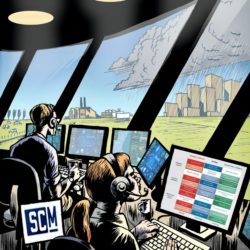The coronavirus supply chain
The media coverage of supply chain has increased exponentially as a result of the coronavirus epidemic in China, South Korea and Italy. All companies that produce and ship tangible goods are currently working hard to assess the impact of the outbreak on their own supply chains.
Professor Yossi Sheffi from the Massachusetts Institute of Technology (MIT) in Boston advises firms to conduct scenario analysis to minimize the business risks. Incidentally, although many factories in China have now resumed operations, he does not expect this to bring rapid relief to the problems. He warns that – just as during the financial crisis in 2008 – companies will continue to be affected by the so-called bullwhip effect for some months. Stockpiling and panic buying due to uncertainty are causing huge fluctuations in demand and supply.
Sales & operations planning
Most firms in the supply chain work with a monthly decision-making cycle based on sales & operations planning (S&OP) or the financial version: integrated business planning (IBP). In theory, companies with S&OP and IBP can look 18 months ahead, calculate the likely shortfall with respect to their financial budget, and decide what they need to do to close the gap. I’d love to know how companies’ S&OP meetings are going during the current coronavirus crisis. In China, South Korea and Italy, there has been some drop in product demand, and at the same time it’s virtually impossible to ship goods from those countries.
Assessing the full impact of coronavirus requires end-to-end supply chain analysis at three levels. At strategic level, a company must assess the risks facing crucial suppliers to its own suppliers and the financial vulnerability of the sales channels. At tactical level, the company can use the S&OP process to zoom in on the demand planning and supply planning: how much demand is expected, and what can still be produced? And at operational level it’s about gaining insight into the upstream availability of raw materials and parts, what’s going on in factories and warehouses, and product shipments.
Assessment of end-to-end supply chain visibility
Supply Chain Media has collaborated with companies such as Henkel and Unilever to convert this three-level approach into a self-assessment of end-to-end supply chain visibility. This free-of-charge tool, which comprises 90 yes/no questions, quickly reveals a company’s supply chain vulnerabilities and blind spots – and knowing that could be invaluable in the current coronavirus situation.
Martijn Lofvers, Chief Trendwatcher Supply Chain Media
martijn.lofvers@supplychainmedia.nl









